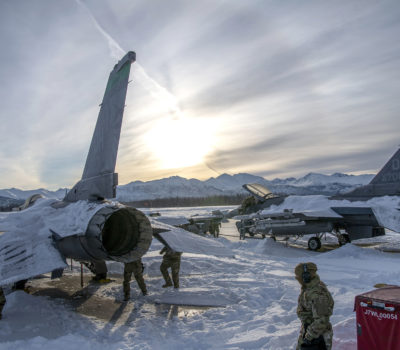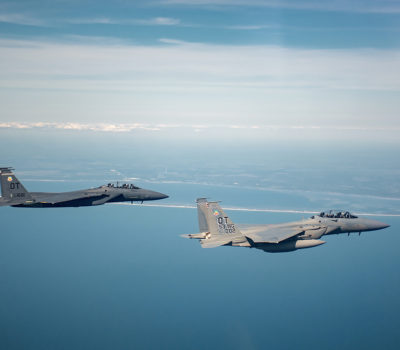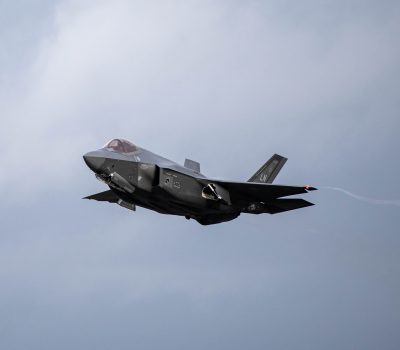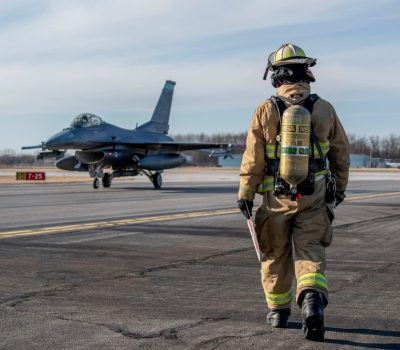F-15 Electronic Warfare System Completes Operational Testing, IOC Looms
Pentagon Wants to Make Commercial Space ‘Integral,’ Especially in These Areas
F-35s Deploy to Poland to Keep ‘Safeguarding’ NATO
New Air Force Safety Plan Focuses on Nukes, Space, and ACE
Radar Sweep
Taiwan’s Strongest Earthquake in Nearly 25 Years Damages Buildings and Causes a Small Tsunami
Taiwan’s strongest earthquake in a quarter century rocked the island during the morning rush April 3, damaging buildings and creating a tsunami that washed ashore on southern Japanese islands. There were no immediate reports of deaths or injuries, and the tsunami threat largely passed about two hours later.
Iran Vows Retaliation on Israel after Commanders’ Deaths, Growing Fears of War Spiraling
On April 2, Iran vowed retaliation for the suspected Israeli attack on its embassy compound in Damascus that killed two of the country’s top commanders. The attack also killed five military advisers in the Islamic Revolutionary Guard Corps, Iran’s immensely powerful military and political organization.
Here Are the First 14 Bases to Experience New Privatized Household Goods Moves
Service members and families at 14 stateside U.S. military installations will be the first to relocate under the Defense Department’s new privatized process, U.S. Transportation Command announced April 2. In the beginning, only moves picked up and delivered within about 50 miles of the same base will be carried out by HomeSafe Alliance, the entity formed by existing logistics firms that won the military’s Global Household Goods Contract and is set to take over management of household goods shipments.
Ukraine’s Arms Industry Is Growing, but Is It Growing Fast Enough?
It is widely agreed that Ukraine needs to rebuild its domestic defense industry so that its military will not have to rely for years to come on the West, which has at times hesitated to send sophisticated weapons systems—including air defenses, tanks, and long-range missiles. Whether that can be done in time to alter the trajectory of a war that would be all the more tenuous without more U.S. military aid remains to be seen.
Air Force Fuel Barge Is First to Use New Baltimore Bridge Site Channel
A tugboat pushing a fuel barge was the first vessel to use an alternate channel to bypass the wreckage of Baltimore’s collapsed Francis Scott Key Bridge, which had blocked traffic along the vital port’s main shipping channel. The barge supplying jet fuel to the Department of Defense left late April 1 and was destined for Delaware’s Dover Air Force Base, though officials have said the temporary channel is open primarily to vessels that are helping with the cleanup effort.
The Air Force Is Quietly Revolutionizing Parts Replacement
The U.S. military spends billions on replacement parts for aircraft each year, with the Air Force requesting $1.5 billion for parts in the next fiscal year alone. Now, officials at Robins Air Force Base in Georgia, working with a startup called Machina Labs, say they’ve found a robotic AI-driven solution to those high costs. The new technique could also shorten the supply chain, allowing replacement to happen closer to the front lines.
General Electric Completes Spinoff of Aviation Engines Business, Launching GE Aerospace
American industrial behemoth General Electric on April 2 completed the spinoff of its aviation and energy businesses, launching GE Aerospace as a standalone company. The event is the final step in the long-awaited break up of General Electric into three individual companies, first announced in 2021, and signifies a new age for one of the two major US aviation engine manufacturers, with its defense engines unit making up about $9 billion of GE Aerospace’s $32 billion portfolio.
Seeking to Make F-35s Ready for War, Maintainers Think Outside the Box
The Joint Strike Fighter program stands in contrast to most other military aircraft programs: Lockheed Martin plays an outsized role in jet readiness, with the company responsible for maintenance planning and management, distribution of repair parts and supplies, engineering, maintenance training, and more. The government’s F-35 Joint Program Office, or JPO, oversees the global fleet of F-35 jets and manages the facilities and people that support maintenance.
Task Force Lima Preps New Space for Generative AI Experimentation
The Pentagon’s Task Force Lima team is getting set to launch a new “virtual sandbox” hub where military personnel will be able to responsibly experiment with approved generative artificial intelligence tools that hold potential to enhance their work. “We already have the plans. It’s a matter, now, of executing on those plans,” Navy Capt. M. Xavier Lugo recently told DefenseScoop.
Russia’s Shahed-136 Factory Attacked by Light Plane Converted into a Drone
Less than a month after we got our first glimpse inside the Russian factory where license production of the Iranian Shahed-series one-way attack drone is taking place, a Ukrainian attack appears to have been launched against the facility. The April 2 attack may well have been the longest-range aerial strike launched by Ukraine so far and it appears to have involved a previously unseen drone that was converted from a light manned aircraft.
B-52 Bomber Makes Rare Landing at Tokyo Air Base, Second Such Visit since July
A B-52H Stratofortress diverted April 2 to Yokota Air Base in western Tokyo, the second such visit in less than a year. The bomber landed at 5:22 p.m. safely and without incident, a spokesman for 374th Airlift Wing, Master Sgt. Nathan Allen, said by email.
Air Force Begins Phase 2 of Enterprise IT Service Delivery
The Air Force is out with a new multiple award solicitation to modernize all of its base network infrastructure. The request for proposals uses the phrase, “enterprise IT-as-a-service” only a handful of times, but for all intent and purposes, this potentially 10-year contract with a $12.5 billion ceiling is considered Wave 2.
Russia, China Catching up to US in Space Weaponry, New Report Finds
The Secure World Foundation on April 2 released its annual report, “Global Counterspace Capabilities: An Open Source Assessment,” that sheds light on the growing space arms race between the United States, Russia and China. The report, compiled from publicly available information, details the counterspace capabilities—essentially space weapons—being developed by a dozen countries. Notably, it finds that Russia and China are rapidly catching up to the United States in key areas like electronic warfare and space domain awareness.
The Air Force’s New $60 Million Special Warfare Aquatics Center Honors a Fallen Pararescueman
Mike Maltz was already a pararescue legend when he submitted his retirement paperwork in early 2003. But within days, the master sergeant pulled it back, accepting instead a final assignment to lead a team of relatively inexperienced PJs, as Pararescue specialists are known, from the 38th Rescue Squadron on an Afghanistan deployment. On March 23, 2003, during a mission to retrieve two Afghan children from a remote village, the Air Force HH-60 he was on crashed in a pitch-black valley, killing Maltz and five others. April 2, the Air Force christened the Maltz Special Warfare Aquatic Training Center, a $60 million, 76,000-square foot training hub at Joint Base San Antonion-Lackland.





